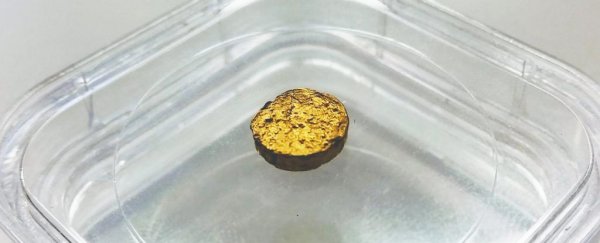It might look like any old 18-carat nugget of gold, but it hides a secret. Produced in the lab, this shiny disc weighs just a fraction of what it should, and has other interesting properties to boot.
Unlike a typical chunk of the bright metal, here the gold nanocrystals are held together with a framework of protein fibres and polymer latex, giving it a much lower density than regular gold.
The research team who developed this material thinks weight can be reduced by up to 5-10 times compared to the standard mixture used for gold trinkets – three-quarters gold, one-quarter copper – which means watches and jewellery could soon get significantly lighter.
Replacing the metal alloys usually mixed with gold to lighten the weight and reduce the density could have benefits beyond jewellery as well, in fields such as chemistry, electronics, and radiation shielding.
"This gold has the material properties of a plastic," says material scientist Raffaele Mezzenga, from ETH Zurich in Switzerland.
"As a general rule, our approach lets us create almost any kind of gold we choose, in line with the desired properties."
To achieve these results, the scientists mixed gold nanocrystals, protein fibres, and a polymer latex with water and salt to create a gel, before replacing the water with alcohol. When put into a high pressure CO2 chamber, the alcohol reacts with carbon dioxide, producing a gossamer-like aerogel.
With the application of heat, that aerogel can be moulded as needed. It can be shaped at just above 105 degrees Celsius (221 degrees Fahrenheit), which is much lower than the 1,064 degrees Celsius (1,947 degrees Fahrenheit) needed to melt pure 24-carat gold.
As you can see from the video below, when dropped, the material acts and sounds like plastic, but the genuine 18-carat purity is preserved.
"This new 18-carat gold can fill a niche which is currently unoccupied in the realm of industrially relevant gold blends and open the way to unexplored applications," write the researchers in their paper.
What helps the gold chunk achieve its lightness are the many microscopic air pockets inside it. The overall density of the material is a mere 1.7 grams per cubic centimetre, compared to around 15 g/cm3 for 18-carat gold made with a metal alloy.
People do tend to associate weight with quality when it comes to gold and jewellery in general, so it may not end up replacing the materials used to make bracelets, watches, necklaces and other items – but there are plenty of other options for putting this lightweight, low-density gold to good use.
Mezzenga and his colleagues previously created super-light gold from milk protein – light enough to float on top of a cup of coffee – but its properties made it difficult to get it into places where gold is used. The new version should have a much wider range of potential applications.
"The [previous] material was too unstable and couldn't be worked," says Mezzenga. "This time we set ourselves the clear goal of creating a lightweight gold, that can also actually be processed and used in most of the applications where gold is used today."
The research has been published in Advanced Functional Materials.
